Ro: November Opening
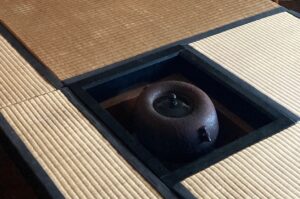
The ro, 炉, the sunken hearth, is opened in November on the first day of the Wild Boar, I, 亥, after Ri-ttō, 立冬, Start-winter, often around November 7th or 8th. The Boar is one of the twelve zodiac signs of the lunar calendar, so the date varies from year to year. Because of this variance, Rikyū was asked when to open the ro. He answered, “when the yuzu turns yellow”, which is when it is cold enough: yuzu, 柚, is a kind of citrus. The sign of the Boar is the last of the twelve zodiac signs, which begins with the sign of the Rat.
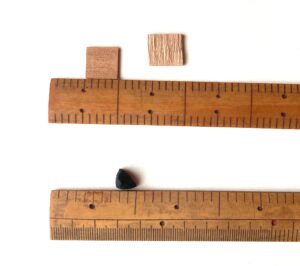
Two squares of byaku-dan, 白檀, white-sandalwood, 5 bu kane-jaku, and kane-jaku, 曲尺, bend-span, and a small piece of neri-kō, 練香, knead-incense; formed into a four-sided tetrahedron, sides, 2.25 bu kujira-jaku, and kujira-jaku, 鯨尺, whale-span. This four-sided form is found in o-kyū, お灸, hon.-moxa cautery, moxibustion, a miniature pyramid of yomogi, 蓬, mugwort, is formed, placed on acupressure points, and lit to burn and stimulate the qi. The Kanji 灸 is composed of kyū, 久, long time, and ka, 火, fire. Byaku-dan, 白檀, white-sandalwood, has 8 edges, neri-kō 6 edges, Infinity in Time and Space.
Incense burned in the portable fu-ro, 風炉, wind-hearth, is byaku-dan, 白檀, white-sandalwood, in small pieces of wood. Although the furo can be used throughout the year, it has been used primarily in the warm half of the year. The ro is used in the cold half of the year. The traditional incense put in the ro hearth is neri-kō, 練香, knead-incense, which is a blend of aromatics. Because nerikō is damp, Rikyū advised to put it into a ceramic kōgō.
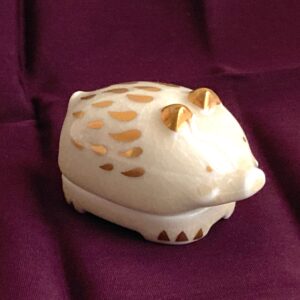
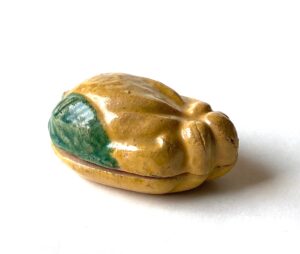
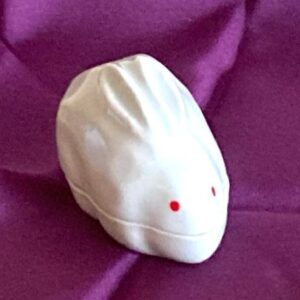
Left: kō-gō, 香合, incense-gather; porcelain, inoshishi, 猪, boar, L. 2.4 sun kane-jaku. Gift of Shio-tsuki Ya-e-ko, 塩月弥栄子, Salt-moon Increase-splendor-child. ‘I-no-shishi’ may evoke wordplay on i no shi-shi, 井の獅子, well’s lion-of.
Center: kō-gō, 香合, incense-gather; ‘raku’ ceramic with yellow and green glazes, Bu-sshu-kan, 仏手柑, Buddha-hand-citron, ‘Raku’ yaki, 楽焼, Pleasure fired, L. 1.8 sun kujira-jaku. The busshu-kan is an alternative to the yuzu.
Right: kō-gō, 香合, incense-gather; porcelain covered container in the form of an usagi, 兎, hare, modeled on a hare made of snow with eyes made of berries from the nan-ten, 南天, south-heaven, nandina.
Incense containers, kō-gō, 香合, incense-gather, for ro-biraki, 炉開, hearth-open, are usually made of ceramic, and are often in the form of boars, and yuzu. It should be remembered that a kō-gō in the form of the animal identified with the current zodiac year can be included. The year 2023 has the sign of the U, 卯, Hare.
In Chanoyu, the sunken hearth is opened on the first I no hi, 亥の日, Boar’s day, of the 10th month of the kyū-reki, 旧暦, old-calendar. According to Japanese traditional architecture, the ro is a permanent part of a Tearoom, which is usually covered over when not in use. Therefore, the floor has to be opened to reveal the hearth, hence ‘opening’ the ro. This day varies greatly, as the zodiac cycle of twelve animals is different each year. In addition, the 10th month is not November, but is identified with one of the periods of the Ni-jū-shi sekki, 二十四節気, Two-ten-four division-spirit, of the solar calendar year.
The ‘tenth’ month begins on Ri-ttō, 立冬, Start-winter, which occurs on or around November 7 or 8, and is called I no Tsuki, 亥の月, Boar’s Month. The zodiac sign of the Wild Boar is the last sign of the cycle of the Jū-ni-shi, 十二支, Ten-two-branch. The ro is opened after the start of Ri-ttō, 立冬, Start-winter, so that the day and month are both identified with the Wild Boar. The Buddhist deity that is the guardian of the sign of the Wild Boar is A-mi-da, 阿弥陀, Praise-increase-steep. Amida symbolizes the element of fire and the transmutation of desire and attachment.
The Wild Boar sign was chosen because it is the last of the twelve animal signs of the zodiac, so that to start something on the last carries it into the next cycle, which begins with the sign of the Rat, Ne, 子. There is a continuance. Joining the Boar to the Rat is I no Ko, 亥の子, Boar ’s Rat. ‘Ko’ is another reading for Rat. The charming result of a misunderstanding of inoko, is a tasty sweet called inoko mochi, 亥の子餅, boar’s child rice cake, which are fashioned to look like baby boars. Happily, such treats are most welcome at the opening of the ro.
![]()
In Shintō belief, the god of fire is Ho no ka-gu tsuchi no kami, 火之迦具土神, Fire ’s (sound)-tool earth-god. He is the child of Izanami and Izanagi, and when he was born, his mother was burned to death.
The essential design of the floor of the yo-jō-han, 四畳半, four-mat-half, Tea room is a square composed of nine squares. This pattern is manifest in the Kon-gō-kai Man-da-ra, 金剛界曼荼羅, Gold-strength-world Wide-weed-spread. The pattern is called ku-e, 九会, nine-groups, and each square contains numerous Buddhist deities. The central square called the Jō-shin-e, 成身会, Become-body/person-group, is one of the sections of the Kon-gō-kai Man-da-ra, 金剛界曼荼羅, Gold-strength-world Wide-weed-spread. In the vernacular, Jōshine is translated as Adulthood Association. The principal deity of Jōshine, as with eight of the nine squares of the Kongōkai Mandara, is Dai-nichi Nyo-rai, 大日如来, Great-sun Like-become.
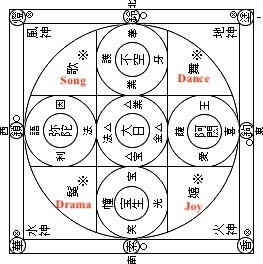
In the Jōshine, there are four deities surrounding Dai-nichi Nyo-rai, 大日如來, Great-sun Like-become, and to his right (left in the picture) is Amida Nyorai. The square of the Kongōkai that does not feature Dainichi is the square in the northwest corner, which is called Ri-shu-e, 理趣会, Reason-meaning-group, and is identified with Amida. It is in this square that many of the Tea utensils are arranged. Between these deities are Bosatsu, 菩薩, Grass-buddhas, which are identified with Kanji related to their gifts to the world.
Dainichi Nyorai in the center of the Jōshine gave to the world shi-kyō, 四供, four-offerings, in the form of four Bosatsu, 菩薩, Grass-buddhas. They bestowed on the world four adamantine joys: Kon-gō-ki, 金剛嬉, Gold-strength-joy; Kon-gō-ban, 金剛鬘, Gold-strength-wig (wig as in theater drama); Kon-gō-ka, 金剛歌, Gold-strength-song: Kon-gō-bu, 金剛舞, Gold-strength-dance. Each in separate directions. The word kon-gō, 金剛, gold-strength, is the translation of the Sanskrit word vajra, which usually means thunderbolt and diamond. The intention is that vajra is unyieldingly permanent.

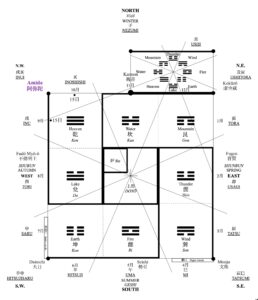
Left: diagram of Jō-shin-e, 成身会, Become-body-group, the center square of the nine squares of the Kon-gō-kai Man-da-ra, 金剛界曼荼羅, Gold-strength-world Wide-weed-spread. Right: diagram of the yo-jō-han, 四畳半, four-mat-half, Tearoom. The center square of the yojōhan may be identified with the Jō-shin square of the Taizōkai Mandara.
Jō-shin, 成身, become-body, means to become a human being, a person, an entity. In a familiar Buddhist expression, San-shoku shō-jō-shin, 山色清浄身, Mountain-color/form pure-pure-body; the land is like the pure, pure body/person of the Buddha.
In taking human form, the Jū-hachi-kai, 十八界, Ten-eight-worlds, becomes manifest as eighteen categories of all existence from the perspective of our cognitive relationships. Sense organs: Ro-kkon, 六根, Six-roots: me, 眼, eye, mimi, 耳, ear, hana, 鼻, nose, shita, 舌, tongue, mi, 身,body, i, 意. mind. Ro-kkyō, 六境, Six-boundaries: iro, 色, color, oto, 声, voice, kaori, 香, smell, aji, 味, taste, shoku, 触, touch, nori, 法, law. Roku-shiki, 六識, six-perceptions; mental functions: visual perception, auditory perception, nasal perception, tongue perception, body awareness, and consciousness.
In the corners of outer square of the Kongōkai Mandara, are four Kanji that represent aspects of Kon-gō, 金剛, Gold-strength, meaning adamantine, permanent, vajra, diamond: kō, 香, southeast incense; ke, 華, flower, southwest; tō, 燈, lamp, northwest; zu-kō, 塗香, powder-incense, northeast, used to rub on images and the body for purification and cleanliness. The first three offerings are the standard Buddhist offerings.
In the four corners of the Joshine square, just inside the outer square are four Kanji identifying offerings. In the upper left – Sui-shin, 水神, water god, upper right Fū-shin, 風神, Wind-god; lower right Chi-shin, 地神, Earth-god, lower left Ka-shin, 火神, Fire-god.
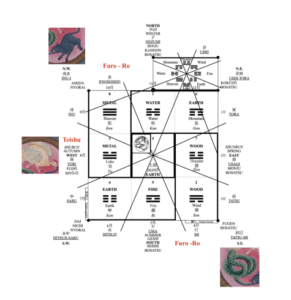
The fire in the ro may have deep roots in the Buddhist concept of the three hindrances of enlightenment, which are identified as the San-doku. The San-doku, 三毒, Three-poisons or three fires, are Ton, 貪, Desire, Jin, 瞋, Anger, Chi, 癡, Ignorance. They are represented by the pig, chicken, and snake. Perhaps the following is conjecture. Each of the three animals are manifest in the Asian zodiac, jū-ni-shi, 十二支, ten-two-branches. The pig is the I, 亥, Wild Boar, which the Chinese identify as a pig. The snake is the Mi, 巳年, Snake. The chicken is the Tori, 酉, Cock. The Wild Boar is identified with the 10th month, the west-northwest direction, and A-mi-da Nyo-rai, 阿弥陀如来, Praise-increase-steep Like-become, located in the northwest corner of the yojōhan, which is where the Tea utensils are arranged. The Snake is identified with the 4th month, east-southeast direction, and Fugen Bosatsu, and is located in the southeast corner of the yojōhan, which is the location of the nijiri-guchi, entrance to the Tearoom. The Cock is identified with the 8th month, the west, and Fu-dō Myō-ō, 不動明王, No-move Bright-king, which is the location of the tei-shu, 亭主, house-master.
These identifications are not solely present on the sides of the yojōhan, but extend outward from the center of the Tearoom.
The three animals represent the frailty of human beings that poison lives, whereas the zodiac animals that are associated with Buddhist deities have other fruitful aspects that contribute to understanding of human nature and lead to enlightenment. One especially creative creature is the zodiac snake, which is associated with Fugen Bosatsu.
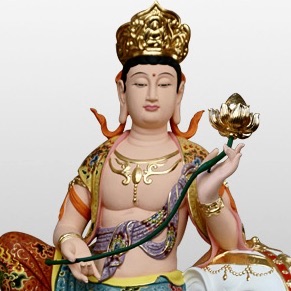
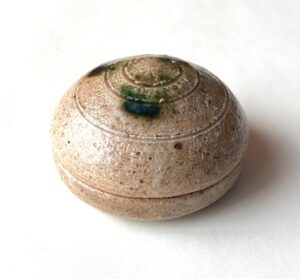
Figure of Fu-gen Bo-satsu, 普賢菩薩, Universal-wisdom Grass-buddha, China. Right: kō-gō, 香合 , incense-gather, in the form of a hō-ju, 宝珠, treasure-jewel, ki-Se-to yaki, 黄瀬戸, yellow-Rapids gate-fired, illegible signature; diam. 2 sun kane-jaku.
Fu-gen Bo-satsu, 普賢菩薩, Universal-wisdom Grass-buddha, is usually depicted riding a white elephant, and is identified with the southeast and the zodiac sign of the mi, 巳, snake. The animal snake is hebi, 蛇. Some images of Fugen depict him holding a long-stemmed hasu no hana, 蓮の花, lotus’s flower, his left hand near the flower holding it upright, his right hand lower holding the end of the stem. Atop the lotus flower is a depiction of a hō-ju, 宝珠, treasure-jewel. Fugen’s snake is often depicted encircling the hōju. The very long green lotus stem, may evoke Fugen’s snake.
The hōju kōgō can be used solely on its own, however, the hōju is associated with many deities in Buddhism and Shintō, as well as the snake and the dragon. When the hōju kōgō is depicted with a dragon, there are usually motifs of three dragon talons, hence a hōju without talons may be associated with the snake as they have no claws.
![]()
Tanya’s Take
The Three Poisons, known in Sanskrit as kleshas, are the three primary afflictions that give rise to actions that result in the continuation of what is known, in both Hindu and Buddhist traditions, as samsaric existence, which is the continuous cycle of death and rebirth.
The life cycle of the three poisons begins with the observation of stimulus, this is followed by the evaluation of stimulus, then comes the reaction to stimulus, and finally there is an action taken. The stimulus is something either in the external or internal environment that is observed. It is then evaluated as either unpleasant, pleasant, or neutral. From this evaluation a reaction is formed, and from this reaction an action is taken, either in the form of a physical change or an emotional change.
There are three evaluations resulting from exposure to stimulus: pleasant, unpleasant, and neutral. There are also three reactions resulting from evaluation of stimuli: attraction, aversion, and disinterest. It is the phases of reaction and action over which one has control and can change. This capacity and its outcome is what determines whether the stimulus generates a poison or not.
For example:
An evaluation that results in the determination that stimulus is pleasant creates the reaction of attraction, and the action of moving towards stimulus and the emotions of craving, desire, greed, etc.
An evaluation that results in the determination that stimulus is unpleasant creates the reaction of aversion, and the action of moving away from stimulus, and the emotions of anger, and those related to anger, struggle, ill will, etc.
An evaluation that results in the determination that the stimulus is neutral creates the reaction of disinterest, and the action of ignoring stimulus, or remaining ignorant to the stimulus and the evaluation.
According to the teachings of Buddhism, stimulus and evaluation always occur. The way one orients oneself to reaction and action is, at least theoretically, under one’s control and is something one can change. This changes one’s relationship within the life cycles of samsara. In other words, the way one orients to stimulus and evaluation contains not only the opportunity to change the future based on how one operates in the present, but it also contains the potentiality for release from cyclic existence, i.e., in not generating the three poisons, one follows the path to enlightenment.
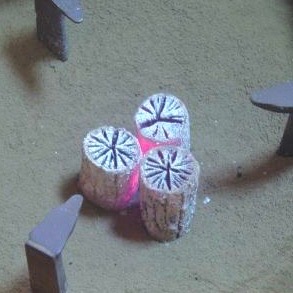
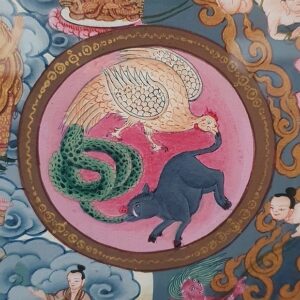
There is a possibility that the san-doku, 三毒, three-poisons or fires, are symbolically manifestations in the three burning pieces of the shita-bi, 下火, down-fire. Within Buddhism, the cycle of reincarnation is depicted in the mandala of the Rin-ne-ten-shō, 輪廻転生, Ring-turn-around-life. The San-doku, 三毒, three-poisons, are Ton, 貪, Desire, Jin, 瞋, Anger, Chi, 癡, Ignorance.
The burning circles of the shitabi may evoke the halo behind the head of a Buddhist deity, such as Amida, which is called the kō-shin, 光心, light-heart.
There may be more meaning than poetic allusion to the look of the charcoal as being kiku-zumi, 菊炭, chrysanthemum-charcoal, as offerings to deity include actual flowers, or the identification of a thing as a flower. An offering of ‘food’ to deity is in the form of bowls of the water, which are symbolic of ‘food’. Foods present on altars, may not be solely offerings, but are intended to be blessed by deity for human consumption.
Perhaps the offerings of water, fire, and food are to appease the deities to overcome the afflictions of the Sandoku.
Fu-ro sumi, 風炉炭, wind-hearth charcoal; 3 shita-bi, 下火, down-fire, dō-zumi, 胴炭, body-charcoal, gi-tchō, 毬打, ball-hit, mallet head, wari-gi-tchō, 割毬打, divided-ball-hit, kuda–zumi, 管炭, cylindrical-charcoal, 2 eda-zumi, 枝炭, branch-charcoal, ten-zumi, 點炭, offer-charcoal.
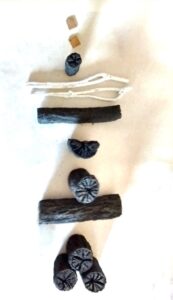
-Kō, 香, incense, 2 byaku-dan, 白檀, white-sandalwood;
Sha-ka Butsu, 釈迦仏, Sakya Buddha
-Ten-zumi, 点炭, Offer-charcoal;
Ko-kū-zō, 虚空蔵, Empty-void-keep: Void
-Eda-zumi, 枝炭, branch-charcoal; ……. Hashi?
-Kuda–zumi, 管炭, tube-charcoal;
Mon-ju, 文殊, Literary-exceptional: Wind
-Wari-gi-tchō, 割毬打, divided-ball-hit;
Sei-shi, 勢至, Strength-attain: Fire
-Maru-gi-tchō, 丸毬打, round-ball-hit, mallet head;
Kan-non, 観音, See-sound: Water
-Dō-zumi, 胴炭, Body-charcoal;
Dai-nichi, 大日, Great-sun: Earth
-Shita-bi, 下火, down-fire, 3 gi-tchō, 毬打, ball-hit, ball-hit, San-doku, 三毒, Three-poisons: Fu-dō, 不動明王, No-move, A-mi-da, 阿弥陀, Praise-increase-steep, Fu-gen, 普賢, Universal-wisdom.
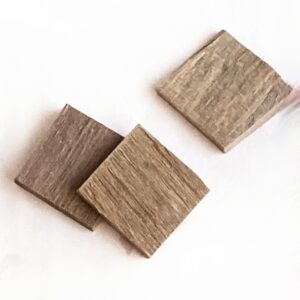
-Shiki-kō, 敷香, spread-incense; three pieces of byaku-dan, 白檀, white-sandalwood, placed on ash bed before placing the shita-bi, 下火, down-fire. Three squares and three circles of the charcoal, and the grouping forms three sides.
In the above identification of charcoal pieces to Buddhist deities, the principal piece of charcoal, the dō-zumi, is identified with Dainichi. Dainichi Nyorai is the universe made manifest, creates all Buddhas, all sentient beings, and the material world, and controls the six elements: Chi, 地, Earth, Sui, 水, Water, Ka, 火, Fire, Fū, 風, Wind, Kū, 空, Void, and Shiki, 識, Consciousness.
Kannon Bosatsu, identified with the maru-gitchō, is the manifestation of the element of Water, which is revealed in the lotus that she holds. The circle is the emblem of Water.
Seishi Bosatsu, identified with the wari-gitchō, is the manifestation of the element of Fire, which is revealed in his hands held together. He is the counterpart of Kannon. (The wari-gitchō is regarded as triangular.)
Monju Bosatsu, identified with the kuda–zumi, is identified with the southeast, the source of ‘good wind’. The kudazumi is evocative of wind passing through it. Monju, in elation, controls the wind energies which remove the subtle knowledge barriers to Enlightenment.
Kokūzō Bosatsu, identified with the ten–zumi, is the manifestation of the Void of the universe, as revealed in his name, Kū, 空, Void, and is the counterpart of Dainichi, who is the physical manifestation of the universe.
The roles of edazumi and byakudan, are at the moment, seemingly unrelated to the above symbolism. However, numbers and evocations may be inferred. Such as the white edazumi resemble bones after cremation of the body. They may also be associated with the kudazumi and wind, and the murmuring sound emanating from the kama, that is called matsu-kaze, 松風, pine-wind. The bifurcated white edazumi resemble fallen pine needles, suggesting impermanence.
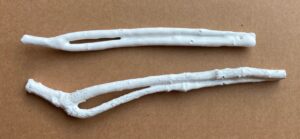
The eda-zumi, 枝炭, branch-charcoal, are made of azalea twig charcoal covered with white gesso-like go-fun, 胡粉, foreign-flour, that is made of ground up hamaguri, 蛤, clam shells. This could evoke the sea and its water to protect against fire. There is a conundrum to these ideas, because in the ‘Godless Month’, October, the edazumi are left charcoal-black without gofun. It is thought that having all black charcoal has a quiet sense of shibui, 渋, an esthetic astringence. It should be remembered that according to Urasenke tradition, the ash bed of the furo is overlaid with black charcoal made of rice straw, so that the entire surface of the ash bed and unburned charcoal is entirely black, except for the glow of the three burning shitabi.
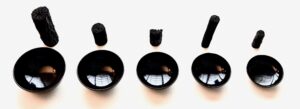
Set of five graduated Buddhist Ō-ryō-ki, 応量器, Accept-quantity-container, food bowls, as used in Chanoyu; from Left: meshi-wan, 飯碗, rice-bowl, shiru-wan, 汁椀, soup-bowl, meshi-wan futa, 蓋, lid, shiru-wan, 蓋, lid, ‘sake’, 酒, sake, Five pieces of fu-ro sumi, 風炉炭, wind-hearth charcoal, from Left: dō-zumi, 胴炭, body-charcoal, maru-gi-tchō, 丸毬打, round-ball-hit, mallet head, wari-gi-tchō, 割毬打, divided-ball-hit, kuda–zumi, 管炭, cylindrical-charcoal, ten-zumi, 點炭, offer-charcoal.
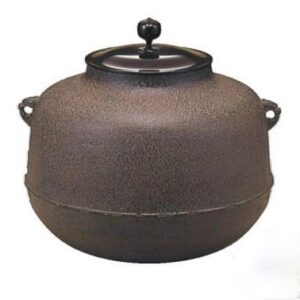
It may be no coincidence that Rikyū’s choice of kettle for the ro was the A-mi-do-dō gama, 阿弥陀堂釜, Praise-increase-steep kettle. The Influence of Amida, guardian of the northwest corner of the yojōhan, extends outward from the center of the room, which includes the location of the ro.
The most beloved kama in the world of Chanoyu is the A-mi-do-dō gama, its background story ties together Rikyū and Hideyoshi, and the opening of the ro. Toyo-tomi Hide-yoshi, 豊臣秀吉, Bountiful-retainer Excel-luck, visited the Zen temple Ran-jaku-in A-mi-da–dō, 蘭若院阿弥陀堂, Orchid-young-institute Praise-increase-hall, near Kobe, 神戸, God-door, where he met Sumi-nishi O-shō, 澄西和尚, Clear-west Harmony-esteem, the head monk of the temple. Hideyoshi thought the monk had a head shaped like that of a wild boar, and asked Rikyū to have a kettle made that resembled it. Rikyū had Yo-ji-rō, 与次郎, Bestow-next-son, create the kettle, and named it ‘I-kubi Kama’, 猪首釜, Boar-neck kettle. The equivalent in English is ‘bull neck’, where there is little difference between the head and the neck. People started calling it the Amida-do kama after the name of the temple, by which copies are known to this day. Yojirō’s Amida-do kama is treasured at Zen-puku-ji, 善福寺, Virtue-fortune-temple, in Ari-ma, 有馬, Have-horse.
The reasons for the ro to be opened in connection with the Wild Boar are numerous and varied. The sign of the Wild Boar is guarded by Amida Nyorai. The start of the old month of the Wild Boar, I-no-tsuki, 亥の月, Boar-’s-month, is November 8. In 2023, the first day of the lunar 10th month is November 13, which is coincidentally also an I-no-hi, 亥の日, Boar-’s-day. It is on this day that the ro is officially opened.
In Pure Land Buddhism, there is the annual memorial service of Hō-yō, 法要, Law-essence, called Jū-ya, 十夜, Ten-night. The rites begin on the night of the 5th day of the 10th month, and lasts for 10 days and 10 nights, ending in the morning of the 15th. During this period of time, is Ri-ttō, 立冬, Start-winter, which begins the month of the Wild Boar that is protected by Amida. This rite is one of the most important events at Shin-nyo-dō, 真如堂, True-like-hall, in Kyōto. Shinnyodō is also the first place where the temple bell is rung 108 times for the New Year.
Tsuitachi, 朔, first day of the lunar 10th month. Ro-biraki, 炉開, Hearth-open. I no Hi, 亥の日, Boar’s Day. I-no-ko mochi, 亥の子餅, Boar’s-child mochi. More fire and light is observed in the ro, as the nights get darker and longer. This may also be the reason for Dewali, the Festival of Lights observed in India beginning with the new moon.
![]()
Shiki-kō, 敷香, spread-incense.
Go-kō, 五香, five-incenses. In Buddhism, there are five rites for which five kinds of incense are burned. They include agarwood, white sandalwood, clove, tulip, and dipterocarp. The five rites are: 1. When building an altar. 2. The realization of all mantras. 3. For Sutra scrolls. 4. When practicing the Peacock Sutra. 5. For the precepts, concentration, wisdom, liberation, and liberation.
Go-bun-kō, 五分香, Five-divisions-incense. The incense is used as a metaphor for the Go-bun Ho-sshin, 五分法身, Five-divisions Law-body, Dharmakaya, Buddhist highest form of existence. The five merits and virtues achieved by unlearned saints on their own are called five-point dharma body. Namely: the body of discipline, the body of concentration, the body of wisdom, the body of liberation, the body of knowledge and view of liberation. If they are compared with fragrance, they are called the fragrance of discipline, the fragrance of concentration, the fragrance of wisdom, the fragrance of liberation, and the fragrance of knowledge and view of liberation.
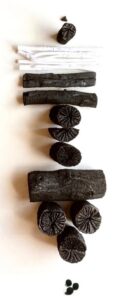
Charcoal pieces for the ro are larger that those for the furo. The lengths are 2 sun and 4 sun kujira-jaku, and are thicker in circumference. There are two pieces of charcoal added to the number of those for the furo: a gi-tchō, 毬打, ball-hit, and a wari-kuda-zumi, 割管炭, divided-tube-charcoal.
Four pieces of eda-zumi, 枝炭, branch-charcoal, are added to the fire.
The incense is neri-kō, 練香, knead-incense; a varied blend of aromatics, mixed with charcoal dust and honey. As the nerikō is damp, Rikyū used a ceramic kōgō. A small piece of nerikō is pictured at the top of the group of charcoal pictured.
Shiki-kō, 敷香, spread-incense, in the ro is three small pellets of nerikō. See picture above of ro with nerikō, which is put into the hearth before the three pieces of charcoal, shita-bi, 下火, down-fire.
Perhaps the charcoal and incense in the ro are symbolic of the Sō-rin, 相輪, 相輪, Together-rings, spire on the top of a Go-jū-no-tō, 五重の塔, Five-tier-’s-tower, a reliquary for the Buddha’s remains.
When sen–kō, 線香, thread-incense, incense sticks are burned for secular purposes, they are placed upright. In some Buddhist sects, the incense sticks are laid down, usually on an ash bed. The ash from upright stick incense falls and scatters like a scattered mind, whereas when laid down, the ashes remain in place. It also purifies the area in front of the altar and is an offering to the Go-hon-zon, 御本尊, Venerable-main-lord, main worship image. Incense in Chanoyu is placed directly on the ash bed, which is logical with nerikō, and difficult to accomplish with chips of sandalwood. Exactly where to place the incense when building the charcoal fire in the presence of the guests is a concern. Some place one of the pieces of byakudan in the center of the fire, and one piece on the dōzumi. The piece of nerikō is placed directly in the middle of the fire.
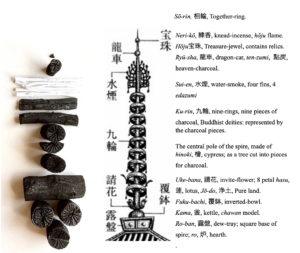
The central pillar of the Go-jū-no-tō, 五重の塔, five-tier-tower, is called the shin-bashira, 心柱, heart-post, also 真柱, true-post, and is made of hinoki, 檜, Japanese cypress, Chamaecyparis obtusai. The pillar is suspended from the roof and otherwise detached from the structure of the building. It is intended to support the sōrin spire.
The Ku-rin, 九輪, Nine-rings, of the sōrin are metal rings with small bells attached. The rings are symbolic representations of nine Buddhist deities. The list of deities begins from the bottom of the spire of the image below.
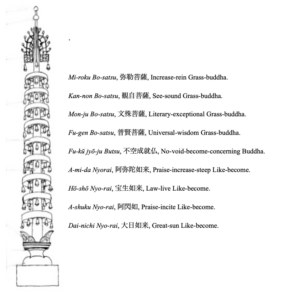
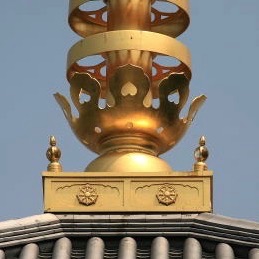
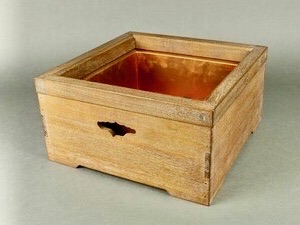
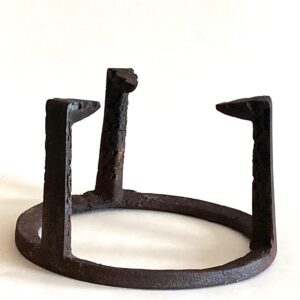
Left: base of sō-rin, 相輪, together-ring; showing square ro-ban, 露盤, dew-tray, and uke-bana, 請花, invite-flower, gilt-metal 8-petal ‘lotus’. Center: portable wooden box oki-ro, 置炉, place-hearth. Right: iron go-toku, 五徳, five-virtue, to support the kama, 釜, kettle, in the hearth.
The ro-ban, 露盤, dew-tray, is a low, square, metal, covered box, with two flamboyant motifs kō-za-ma, 香狭間, incense-confine-interval, with hō-rin, 法輪, law-wheels. Theoretically, the kōzama is an opening from which incense smoke is emitted. The roban is the model for many Buddhist altar bases.
The oki-ro, 置炉, place-hearth, is used in places in lieu of a sunken ro. Note the handle opening of the okiro resembles the kōzama of the roban of the sōrin spire. The okiro is often used with an electrical element modeled on a charcoal fire arrangement, although they have metal liners to accommodate a charcoal fire.
The uke-bana, 請花, invite-flower, sō-rin, 相輪, together-ring, is modeled on an 8-petal lotus that represents Jō-do, 浄土, Pure-land, the western paradise of Amida Nyorai. The tips of the petals arch outward. Right: go-toku, 五徳, five-virtues, rusticated iron trivet with ring base, made for use in the ro, sunken hearth. The three tsume, 爪, talons, angle inward. In Buddhism the ukebana lotus may be represented by the go-toku, 五徳, five-virtue, the iron trivet in the hearth that supports a kama, 釜, kettle. The ukebana is identified with the Buddhist concept of the lotus and its five virtues, ren-ge no go-toku, 蓮華の五徳, lotus-flower’s five-virtues are:
1. O-dei fu-zen, 淤泥不染, mud-attach no-stain. Ash, hai, 灰, in hearth.
2. I-kke i-kka, 一茎一花, one-stem one-flower.
3. Ka-ka dō-ji, 花果同時, flower-fruit same-time.
4. I-kka ta-ka, 一花多果の徳, one-flower many-fruit.
5. Chū-ko ge-choku, 中虚外直, middle-empty outer-straight.
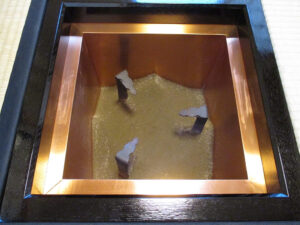
Ro, 炉, hearth, with copper ro-dan, 炉壇, heart-foundation, wood ro-buchi, 炉縁, hearth-frame. The ro has a bed of ash that has mounds on each of its four walls, and valleys in the corners. The gotoku is embedded in the ash so that only the three posts and tsume, 爪, talons are visible.
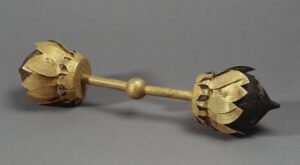
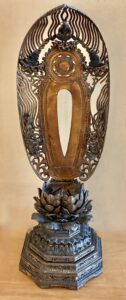
Ren-dai, 蓮台, lotus-support, wooden stand for a sculpted image of Amida. The structure and designs of the rendai as its name indicates, are based on the lotus, hasu, 蓮: the circular seat is the seed pod; the pod seat is surrounded by groups of lotus petals. The flame-like kō-hai, 光背, light-back, is modeled on a lotus petal, and is emanating from a lotus petal base. The encircled eight-petal lotus in the middle is called zu-kō, 頭光, head-light, which would be behind the head of the deity. This halo is also called kō-shin, 光心, light-heart. The halo with the aperture is the shin-kō, 身光, body-light, and would be behind the body of the deity. The opening is modeled on a side view of a lotus flower.
Amida Nyorai often has behind him a flame-like aureole, kō-hai, 光背, light-back, that is likened to the shape of a boat, as it is the means of quickly crossing the sea to enter his western paradise of Jōdo. The kōhai also resembles a lotus petal.
In the picture, there are two lotuses to support the image of Amida, because, for each of his steps a lotus manifests to support him. As the base is for the figure of Amida as part of the rai-go, 来迎, approach-meet, to welcome departed souls to paradise.
Where the kōhai is likened to the lotus petal, perhaps there is some connection between the shape of the lotus petal and the tsume of the gotoku in the hearth.
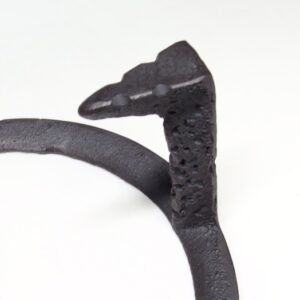
The go-toku, 五徳, five-virtue, has three tsume, 爪, talon, and if the tsume represents the kōhai of a Buddhist image, then there may be a connection between the three tsume and three Buddhist deities. As Amida Nyorai is featured prominently in relationship to the hearth and Chanoyu, then perhaps the three lotus tsume may be identified with the three deities related to Amida, which is the very familiar A-mi-da San-zon, 阿弥陀三尊, Praise-increase-steep Three-lords.
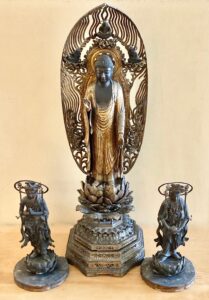
The central image of Amida Nyorai is depicted stepping forward with his left foot, his right foot behind. His left hand is pointing towards the earth, his right hand is pointing to heaven. These positions may be related to the complimentary aspects found in Ayurveda and subtle body anatomy that include the energy channels called ida and pingala that may be likened to In and Yō aspects. When entering the tearoom Urasenke enters with the right foot. In Japan, when entering a sacred space, one enters with the left foot.
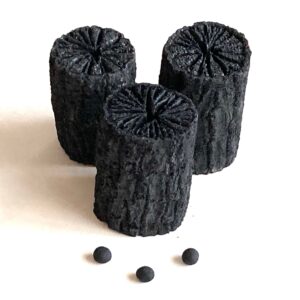
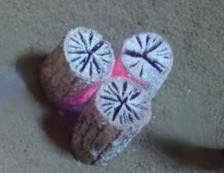
Left: three ro charcoal gi-tchō, 毬打, ball-hit; h. 2 sun kujira-jaku, and three pieces of neri-kō, 練香, knead-incense, that are put in the hearth prior to putting in the three pieces of charcoal of the shita-bi, 下火, down-fire. Right: three burning circles of the shitabi may evoke the halo behind the head of a Buddhist deity, such as Amida, which is called the kō-shin, 光心, light-heart.
When building the charcoal fire, one of the first things that is done, in many ten-mae, 點前, offer-for, is moving the piece of charcoal at the front of the group to the back of the group. This move changes the shō-men, 正面, true-face, of the fire, like a mirror.
For further study, search Robiraki and see also: Opening the Ro, Tea in November, Charcoal: Sumi for Furo and Ro, Furo Ro: Three Forms, and Furo to Ro

